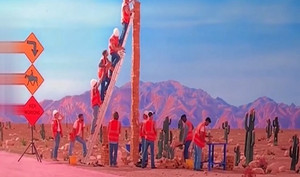
Salzburg Global Fellow Aleksandra Vukotić explores her understanding of borders in the context of the former Yugoslavia

-
Aleksandra's example of an enduring map from before the Balkan War highlights the interplay between historical events, memory, and the imaginative construction of borders.
-
Evaluating the concept of borders as "strange loops" or "Möbius strips," Aleksandra offers an analytical approach that embraces the ambiguities inherent in narratives of belonging, security, inclusion, and exclusion.
-
The permeable boundaries between reality and fantasy echo the contemporary understanding that borders are often far more imagined than real.
This op-ed was written by Aleksandra Vukotić, who attended the Salzburg Global American Studies program "Beyond the Nation-State? Borders, Boundaries, and the Future of Democratic Pluralism" from September 19 to 23, 2023.
My father has always been passionate about maps. As an expert in geodesy, he hung a large relief map of Yugoslavia above my study desk, possibly in the hope that it would develop my spatial orientation through the power of visualization. What it boosted the most, however, was my imagination, as the map soon became obsolete, outliving the delineated state that it formerly represented. Strangely enough, we did not take it down either during or after the war when the demarcation line carefully drawn around Yugoslavia, comprising Slovenia, Croatia, Serbia, Bosnia and Herzegovina, Montenegro, and Macedonia, no longer indicated the presence but the absence of a formerly common territory of the Yugoslavs. Moreover, it clearly demarcated a space of trauma and a territory set apart from what we called “the West”.
Throughout the nineties, while the Balkan region was in a frenzy about the renegotiation of its newly forged borders as barriers and ultimate strongholds of national (no longer Yugoslav) identities, the rest of the world seemed to be taking its first steps in transnational studies and deconstructing the concept of the border, ushering an era of unforeseen mobility. However, what is now popularly referred to as “Balkanization”, the division of larger states into smaller ethno-territories, was not discernible on my map. The borderscape remained largely the same without “hard borders”, other than rivers and mountain ridges, and the barely perceptible, faintly drawn lines around individual federations, even as it was contested daily in the contact zones between the emerging nation-states. The war was searingly real. The borderscape on my map was, to a great extent, phantasmagorical.
Today, my understanding of the concept of the border is largely informed by my passion for contemporary American literature and culture. I see borders as “strange loops” or “Möbius strips”, borrowing one of John Barth’s favorite metaphors, endlessly producing possible, plausible, and impossible spaces between reality and fiction. The metaphor is no less powerful when applied to international relations, as shown by the French political sociologist Didier Bigo, who uses the concept of a Möbius ribbon in his discussion of the internal and external security suggested by the border’s inside/outside divide. Furthermore, as we learn in Barth’s Lost in the Funhouse, a Möbius strip is informed by the contradictory logic of “both and neither”; as a metaphor, it is rather productive and pertinent to the topic of reassessing the border, as it helps embrace a number of paradoxes inscribed in the narratives of belonging, security, inclusion, and exclusion, which typically constitute the poetics of the border in popular and political discourse. Whether from mathematics, literary, cultural, or geopolitical studies, the Möbius loop metaphor offers an analytical approach to the border, exploring its ambiguities and the (im)possible spaces it delineates.
Of course, back in the nineties when I was in primary school, I was unaware of all the implications of the borderscape on my map. Most of the time, I was living in “Barbie Land” and the demarcation lines separating it from the real world were rather porous, much like in Greta Gerwig’s recently released film which employs a set of postmodern strategies to remind us of the permeable boundaries between reality and fantasy. The film resonates with the topic of borders and boundaries, which are constantly pushed, transgressed, and reimagined, both by the people and the dolls who inhabit Gerwig’s multiverse. The borderline between “Barbie Land” and “reality” forms yet another Möbius strip, which shows not only that borders are “far more imagined than real,” in the words of contemporary border theoreticians (Otto & Berthier-Foglar 2020), but also that the very process of bordering multiplies the layers of reality and the possibilities of its interpretation.
A while ago, the relief map of former Yugoslavia was relocated to my father’s study. There, the borderline continues to endlessly reproduce space beyond nation-states, alternating between history and memory, politics and imagination, and converging in the twists and curves of this strange loop.

Pictured: Kens building a wall barrier between “Barbie Land” and “reality” in Greta Gerwig’s Barbie (2023), to “close the portal” between the two worlds and secure the borders of their newly-established “Kendom” and by extension, the rule of patriarchy. The scene is an obvious allusion to the politics of walls and barriers, from the Great Wall of China to the “Trump Wall”, and the absurdity of the act is nicely captured in the wall’s configuration; it is entirely vertical, and the border remains open.
Aleksandra Vukotić is an assistant professor in American literature at the English department of the University of Belgrade in the Faculty of Philology. Her book Don DeLilo i poetika istorije (Don DeLillo and the Poetics of History) was published by Akademska knjiga in 2018. Aleksandra's research interests include contemporary American and Irish literature, critical theory, and political and media studies.
Aleksandra attended the Salzburg Global American Studies program on “Beyond the Nation-State? Borders, Boundaries, and the Future of Democratic Pluralism” from September 19-23, 2023. The 2023 Salzburg Global American Studies Program focused on the contestations and renegotiations of boundaries beyond the nation-state, and how they are changing the representation of democratic pluralism.